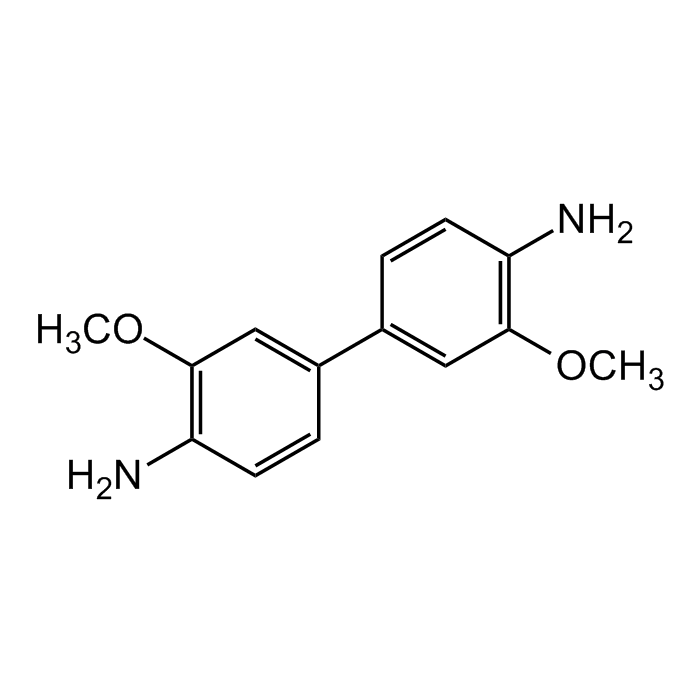Cookie Policy: This site uses cookies to improve your experience. You can find out more about our use of cookies in our Privacy Policy. By continuing to browse this site you agree to our use of cookies.
Chemodex
o-Dianisidine

| Product Details | |
|---|---|
| Synonyms | 3,3´-Dimethoxybenzidine; Fast Blue B; Dianisidine; Acetamine diazo black RD; CI Disperse black 6; Cibacete diazo navy blue 2B; Diato blue base B |
| Product Type | Chemical |
| Properties | |
| Formula |
C14H16N2O2 |
| MW | 244.29 |
| CAS | 119-90-4 |
| RTECS | DD0875000 |
| Purity Chemicals | ≥97.0% (GC) |
| Appearance | Light yellow to brown to pink powder. |
| Solubility | Soluble in methanol (10 mg/ml) or ethanol (10 mg/ml). |
| Declaration | Manufactured by Chemodex. |
| Other Product Data |
Click here for Original Manufacturer Product Datasheet |
| InChi Key | JRBJSXQPQWSCCF-UHFFFAOYSA-N |
| Smiles | NC1=C(OC)C=C(C2=CC(OC)=C(N)C=C2)C=C1 |
| Shipping and Handling | |
| Shipping | AMBIENT |
| Short Term Storage | +20°C |
| Long Term Storage | +4°C |
| Handling Advice | Protect from light and moisture. |
| Use/Stability | Stable for at least 2 years after receipt when stored at RT. |
| Documents | |
| Product Specification Sheet | |
| Datasheet |
 Download PDF Download PDF |
o-Dianisidine is a peroxidase substrate and used as a redox indicator dye. Redox indicators are colorimetric reagents which provide a characteristic color change at a specific electrode potential. o-Dianisidine has been used for neutrophil myeloperoxidase activity (MPO) assay or measurment of glucose-oxidase or caeruloplasmin oxidase. It is used as an intermediate for the preparation of azo dyes, pigments and o-dianisidine diisocyanate, which finds application in adhesives, polyurethane elastomers and resins. It is also used in various industries like leather, paper, plastics, rubber and textiles. It acts as a reagent to detect metals, thiocyanates and nitrites. It is incompatible with strong oxidizing agents.
(1) A.S. Hugget & D.A. Nixon; Lancet 273, 368 (1957) | (2) K.H. Schosinsky, et al.; Clin. Chem. 20, 1556 (1974) | (3) A. Hulanicki & S. Glab; Pure Appl. Chem. 50, 463 (1978) | (4) K. Takayama & M. Miura; Jpn. J. Physiol. 31, 269 (1981) | (5) W.F. Beyer & I. Fridovich; Anal. Biochem. 170, 512 (1988) | (6) K. Hunger, et al.; Ullmann's Encycl. Industr. Chem. (2000) | (7) M. Catala Icardo, et al.; Analyst 126, 2087 (2001) | (8) J. Jasnowska, et al.; Bioelectrochemistry 64, 85 (2004) | (9) E. Perju, et al.; Liq. Cryst. 42, 1309 (2015) | (10) S. Sundaram, et al.; RSC Adv. 5, 45996 (2015)





